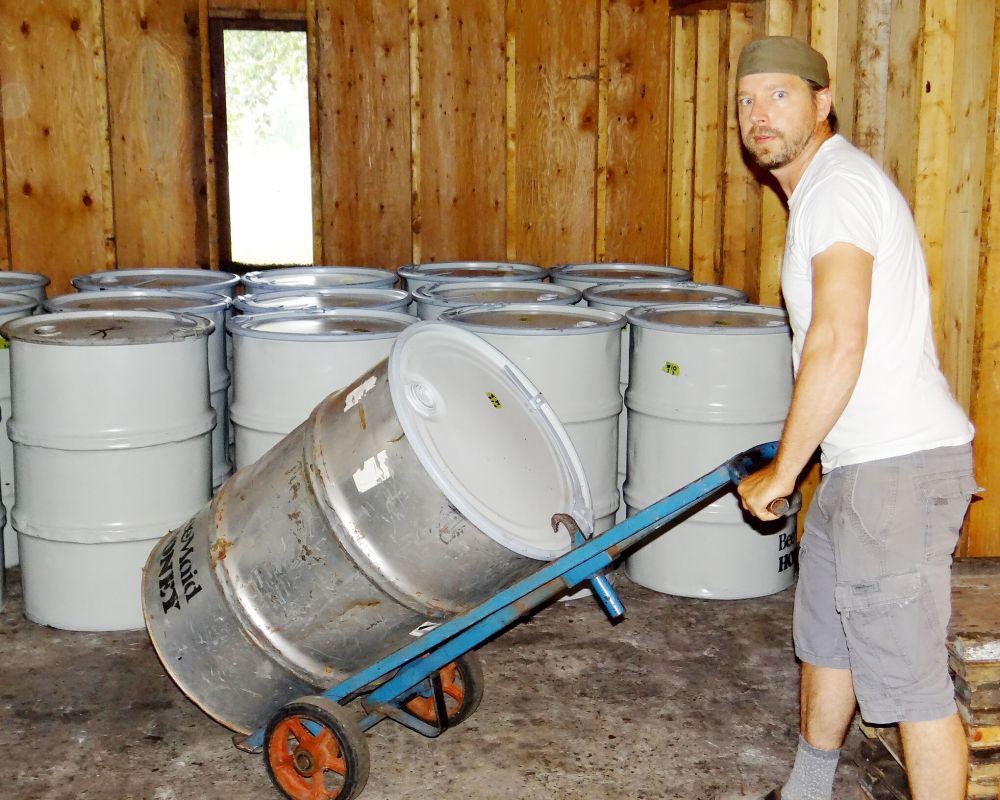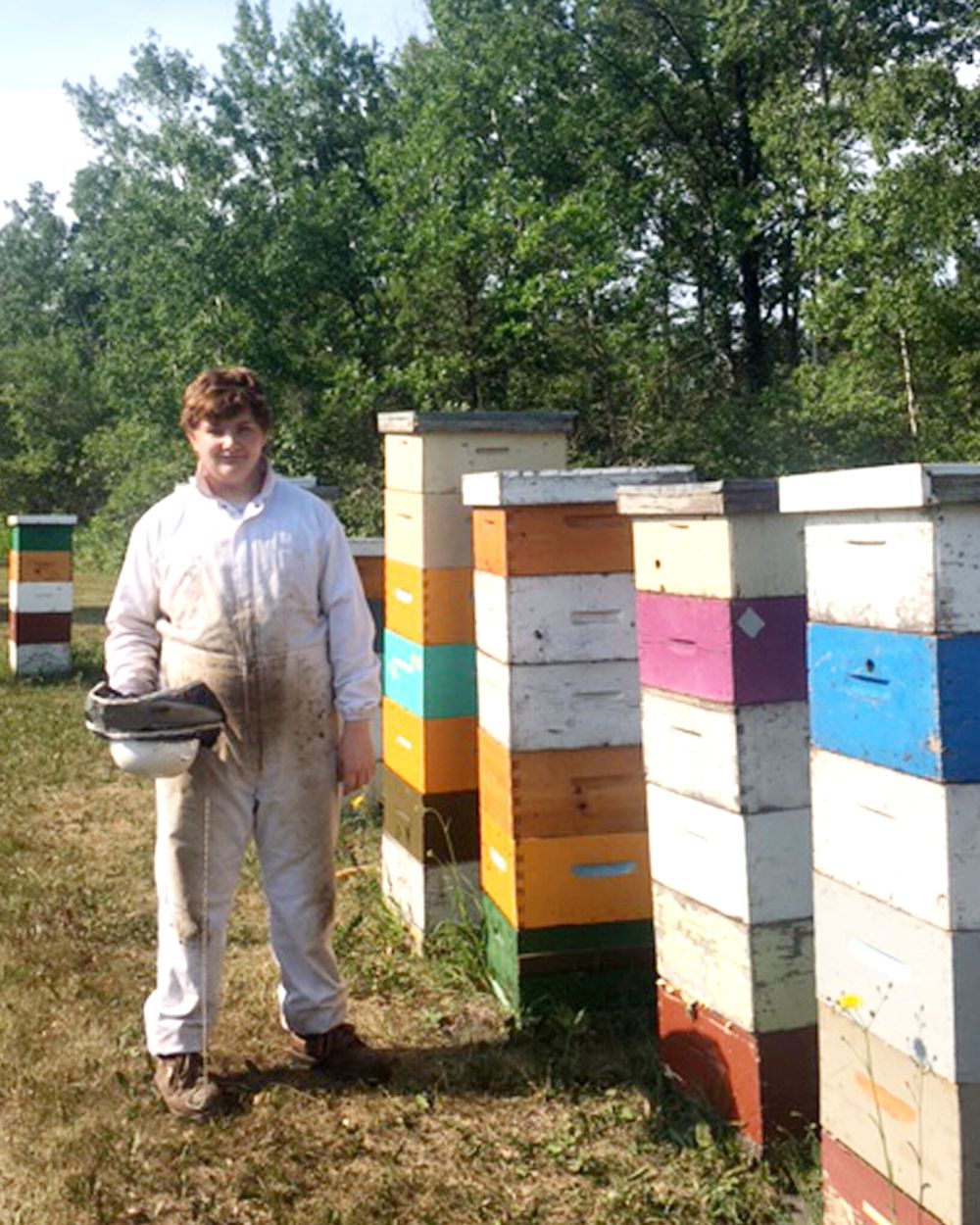Honey of a hobby grows into a family enterprise
Advertisement
Hey there, time traveller!
This article was published 09/10/2021 (1294 days ago), so information in it may no longer be current.
When the former reeve of the Rural Municipality of Ste Anne bought his first 10 bee boxes, 45 years ago, he never dreamed his new hobby would turn into a family enterprise producing more than 100,000 pounds of honey a year.
Art Bergmann says his interest in bees came while spending summers watching Ted Langill drive his cream-coloured truck, loaded with stacks and stacks of bee boxes back and forth past their River Lot residence in the Ste Anne area.
One day Bergmann asked Langill to sell him some boxes, was told he was lucky the man had 10 he could spare, and for an investment of $250 Bergmann instantly became a honey producer.

Until the late 1970s, beekeepers imported queen bees from the United States. Bergmann says theirs came from Texas, but that changed when a parasite was found in the American bee population and the border was closed.
Today, most Manitoba honey producers tend to their bees 12 months of the year, to make sure they are there for the next honey season. Bergmann says that has proved to be very successful for his family and it has been years since they last had to buy new stock.
Gary Bergmann, Art’s son, raises their queens and the Bergmann’s foundation stock winters well, and is frugal on consumption of food stores.
Gary, one of four sons of Art and Lois, grew up spending summers working with his dad and brothers with the Bergmann bees during breaks in university studies. Beekeeping is a perfect summer job for a university student because the break is from May to August, the busiest season for honey producers.
Gary is the one who came back after graduation from university, making the decision he wanted to be a full-time beekeeper.
“When I looked down the road, did I want to teach English in my own little ivory tower or work outdoors with bees, enjoying the wonders of nature? I’d rather be with the bees.”
Gary says his career as a beekeeper has been an evolution for him, starting in the extracting room helping out during breaks from school. He likes to figure things out, and now is involved in grafting cells for the breeding process in raising 300 queen bees every year.
This part of the operation is most important, Art Bergmann explains, as honey production depends on the monarchy. Without the queen, the working bees lose vitality and direction. There is one queen bee per hive and she is in the lowest of the boxes (called supers) that make up the hive. Supers are added to the stack as required, he says. If hive locations are not to be tended weekly, more than one super is added. Some bee yards have stacks of six supers during the season.
Bergmann chuckles at the suggestion that stacks of six boxes may indicate either a good honey crop or a lazy beekeeper. And while there may be such a thing as a lazy beekeeper, there certainly are no lazy bees. Bergmann talks a little bit about the breeding process of bees, kind of a “Birds and the Bees” lecture and it becomes clear where all those bees come from. While the hives have only one queen, after mating in the air, she will lay up to 2,000 eggs a day, Bergmann says. With 600 colonies, that makes for an awful lot of bees during the season.

Overcrowd bees
likely to swarm
If bees become overcrowded, as the colony grows, and there are not enough supers to accommodate them, the result can be disastrous, Bergmann explains. During the busy season, from the beginning of May until the end of August, it is important to keep making sure there are enough boxes out there or the bees will swarm.
“Bees in trees don’t help with your groceries in the winter time.“
That means a beekeeper can expect to spend a great deal of time outdoors in the summer, going from one bee yard to the next, making sure the colonies are all running smoothly.
One of the attractions for Gary, his father says, is the seasonal nature of the work. Gary likes to travel and when he was single he would winter in Central and South America as a volunteer. One year, he built an orphanage in Chile and other years he worked in the Guatemalan forest with indigenous people.
Along the way, he met and married a girl he went to elementary school with in Blumenort.
And just like that, the next generation is following in the footsteps of the founder of Prairie Pride honey, who started with 10 hives as a hobby, and watched his pastime double in a year and grow into a family enterprise, which today has 600 colonies.

Honey production is now over 100,000 pounds annually. This year, Bergmann was surprised at the production they were getting early in the season, despite the hot, dry weather.
Usually when plants are under stress, less nectar is secreted and that’s the first place a slowing up of honey production shows up.
Bergmanns’ bees produce honey from a variety of crops including canola, clover, sunflowers and buckwheat. Wild flowers growing in ditches are also important to beekeepers, Bergmann says.
The Bergmanns market their 50 tonnes of honey a year through the Bee Maid co-operative made up of 300 producers. Their honey is sold in Canada and exported to a number of other countries, with Japan and Korea providing the largest of the export markets.
“In Canada, most grocery stores carry our honey, which is pure with no additives and is packaged by Bee Maid.”
Art Bergmann says when he was a young man he did a lot of value-added production, packaging Prairie Pride honey for stores like Safeway and Vita Health, but today the larger outlets don’t want to deal with the “Mom and Pop” operations. So most of the Bergmann honey is marketed through Bee Maid.
At the honey house, honey frames are unloaded from a convenient indoor loading dock. The honey is prepared for market and shipped in 650 pound barrels to the Bee Maid plant in Winnipeg at Ellice and Roseberry.
“We do have honey house sales and a few places still have Prairie Pride honey on their shelves.”
The Winnipeg Bee Maid plant handles more than 25 million pounds of honey a year, which is more than double the quantity produced a decade ago. A few miles will be shaved off Bergmann’s trips to Winnipeg when a new plant opens on eight acres in the St Boniface Industrial Park which will be under construction next season.

Today, Art Bergmann is a full-time beekeeper, having stepped back, in 2018, from a municipal political career as reeve of the RM of Ste Anne for 16 years.
Art says he decided not to run for re-election in 2018, after winning in a close battle against a political newcomer in 2014.
“As years go by supporters take your re-election for granted and your detractors turn out in increasing numbers. I thought it may be time for a new leader and I didn’t want to wait until I was turfed out.”
After he left municipal politics, Art says he found he has more time on his hands than he had expected. Being reeve is a position, not a job, and you think about your responsibilities 24/7, even while working at your regular job.
Like his son Gary, Art Bergmann would rather be with the bees.
